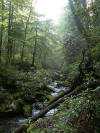Habitat
Photunis marginellus is found in habitats that vary
all the way from moist and semi-aquatic environments, to terrestrial
environments (Luk. et al,
2011) and it ranges from the lands of upper North America all the
way to Northern South America (Townseni, A., 1904). This is because
the Photinus marginellus can survive in a variety of different
habitats. These different habitats include temperate areas,
terrestrial, grasslands, forests, and even very rarely in suburban
areas. This means that the habitats that the Photinus
marginellus able to live within are not specialized. There are
possiblities of great differences and varieties of habitats, along
with a wide range of animals the Photinus marginellus is
able to live in the surroundings of. These animals range from anything as small as a aphid to as big as a bear!
Each area
should be defined to actually be able to see the type of food, which
if interested look at the nutrition page
and
interactions with other animals page
to find out more!
 The first type of area to look at would be
temperate regions. This region can go anywhere from a moderate to cold climate and would be the area that is more easily recognized as
the Tropic of Cancer and the Arctic Circle. This would lead to a
more of a diet of insects (McKenzie, J. 2001). This is only one of
the many different areas that Photinus marginellus is able
to live. In the temperate regions the interactions with other mammal
and insect species is limited, with the exception of its prey. Click
on any of these links to learn more about other animals that live
within this area such as
birds,
mammals, and
insects!
The first type of area to look at would be
temperate regions. This region can go anywhere from a moderate to cold climate and would be the area that is more easily recognized as
the Tropic of Cancer and the Arctic Circle. This would lead to a
more of a diet of insects (McKenzie, J. 2001). This is only one of
the many different areas that Photinus marginellus is able
to live. In the temperate regions the interactions with other mammal
and insect species is limited, with the exception of its prey. Click
on any of these links to learn more about other animals that live
within this area such as
birds,
mammals, and
insects!
 Another area is terrestrial
region which consists of the Photinus
marginellus primarily living on the ground. This happens mostly during times
of rest. The Photinus marginellus likes to refuge among the tall
grass that covers the ground. On the ground Photinus marginellus
have more
of a range of interaction. There are different types of mollusks
which include slugs, and snails that they like to eat, along with a
massive array of insects. Another habitat would be that of the
grasslands or savanna type areas. These are areas that have little
too few trees and is mostly occupied by different types of grasses.
Very similar to the terrestrial landscape. One cool thing about
being terrestrial habitats and living in Wisconsin is that the land
is suitable for Cranberry bog. To learn more about cranberries click
here!
Another area is terrestrial
region which consists of the Photinus
marginellus primarily living on the ground. This happens mostly during times
of rest. The Photinus marginellus likes to refuge among the tall
grass that covers the ground. On the ground Photinus marginellus
have more
of a range of interaction. There are different types of mollusks
which include slugs, and snails that they like to eat, along with a
massive array of insects. Another habitat would be that of the
grasslands or savanna type areas. These are areas that have little
too few trees and is mostly occupied by different types of grasses.
Very similar to the terrestrial landscape. One cool thing about
being terrestrial habitats and living in Wisconsin is that the land
is suitable for Cranberry bog. To learn more about cranberries click
here!
The most common and
understandable is the forest landscape. The forest
coverage is made ferns, grasses, and of course trees. This is where
the Photinus marginellus likes to hide because of its small size,
and is easier to hide from predators. This is the habitat that would
have the biggest variety of food and animal interactions along with
the interactions of the Photinus marginellus predators which would be toad, spiders, bats, and birds.
Even though the habitat of a forest has more resources, it also has
the greatest risks involved with predators (McKenzie,J 2001).
Forest are known for all the different animal, and plant life that
is contains. To look at different plant life click
here and
here!
To look for more information about where the Photinus marginellus lives try looking at the Muesum of Science, Boston who has an incredible chart that shows the range of multiple fireflies along with flash charts.
The Photinus marginellus species are able to live in many habitats and the success of being able to live in the extremely different ranges of temperate to terrestrial to forest landscapes has to do with the adaptations for survival that have evolved among these species. These adaptations which have evolved all relate back to the recent ancestor that allowed for these means of survival. The body regions of the Photinus marginellus have distinct features in each of their compartments to assist in survival in the habitats they have adapted to.
Home <Classification Adapation>